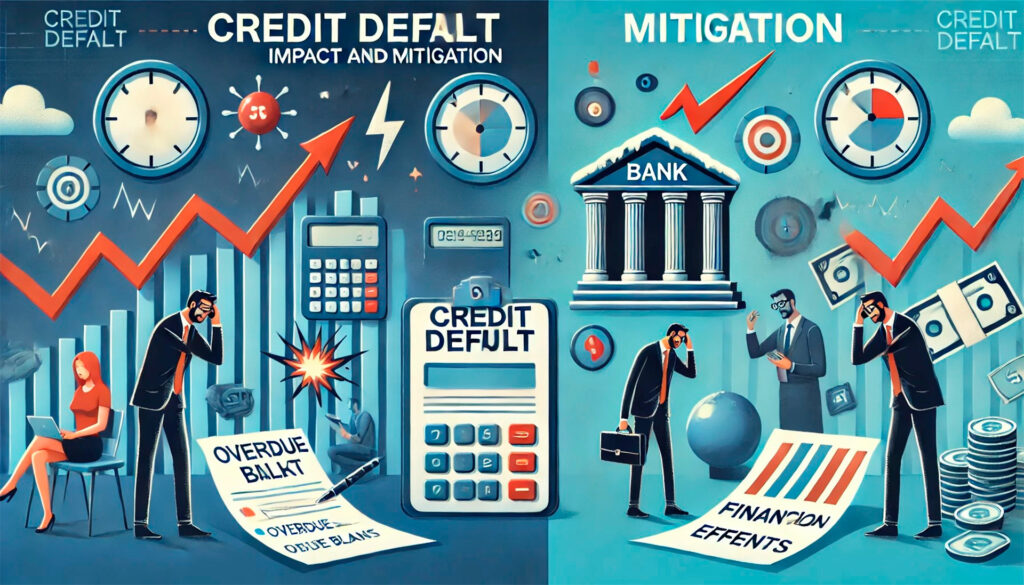Credit default occurs when borrowers fail to meet the required loan payments, directly impacting both borrowers and lenders. Borrowers face a significant drop in their credit scores, making future borrowing tougher and more costly. Lenders deal with financial losses and increased risk. Economic conditions, such as GDP growth, inflation, and interest rates, play a massive role in influencing credit default risk. For instance, a decline in GDP or rising inflation can make debt payments more challenging for borrowers, increasing default rates.
Lenders can use several strategies to mitigate this risk effectively. Options include risk-based pricing, securing loans with collateral, and using third-party guarantees or insurance. Regularly monitoring credit profiles and economic indicators allows lenders to detect financial distress early and adjust their strategies accordingly. Credit default swaps (CDS), acting like insurance, also play a critical role by transferring the risk to another party, providing a vital layer of protection for lenders and investors.
Implementing sound credit management plans helps businesses prevent defaults. Actions such as assessing creditworthiness, setting clear credit policies, and continuous monitoring of credit profiles are essential. Automating these processes with appropriate tools can enhance efficiency. Communicating with lenders, like the company you’re likely in touch with, can lead to negotiated settlements or repayment plans, reducing the negative impacts on your credit score and financial health. Understanding these tactics ensures a proactive approach to credit default risk, fostering stability and resilience.
What Is Credit Default And How Does It Impact Borrowers And Lenders?
A credit default happens when you fail to make required payments on a loan or credit card as agreed in the loan agreement. This can occur with personal, mortgage, auto, student loans, and credit cards.
When you default on a loan, your credit score suffers significantly, making it harder for you to secure future loans and likely resulting in higher interest rates. Lenders can also take legal action, such as lawsuits or wage garnishments, and might repossess assets like cars or homes. Managing the fallout from a default can cause severe stress and financial difficulty, including aggressive collection efforts by debt collectors.
For lenders, defaults lead to financial losses as they miss out on expected income from loan repayments. They may also incur additional costs associated with debt recovery efforts. Dealing with defaults can strain their resources, requiring extra time and money for legal proceedings or collections. This often results in lenders tightening their credit policies, making it harder for other potential borrowers to obtain loans.
To sum up, a credit default negatively impacts both you and the lender, damaging your financial health and their bottom line. If you find yourself at risk of defaulting, it’s crucial to communicate with your lender to explore possible solutions, such as renegotiation of terms or setting up a repayment plan.
How Do Economic Conditions Contribute To Credit Default Risk?
Economic conditions significantly impact credit default risk. When the economy declines, you might see businesses struggling with lower sales and profits, while individuals face job losses or reduced incomes. This can lead to missed loan payments and higher default rates.
Key economic factors that influence default risk include GDP growth, inflation, and interest rates. For example, a drop in GDP or high inflation can reduce your purchasing power, making it harder to service debt. Additionally, rising interest rates increase borrowing costs, leading to higher default rates as your loan repayments become more expensive.
To effectively manage this risk, you should closely monitor economic indicators. This helps you anticipate changes in credit default risk and adjust your financial strategies accordingly.
To wrap things up – understanding how economic conditions affect credit default risk empowers you to make better financial decisions by keeping an eye on key indicators and adjusting your strategies.
What Strategies Can Lenders Use To Mitigate Credit Default Risk?
To mitigate credit default risk, you can use several strategies:
First, consider risk-based pricing. Adjust your interest rates based on the borrower’s risk level, having high-risk borrowers pay higher rates. Another approach is using collateral. Secure your loans with assets to ensure that if the borrower defaults, you can sell the collateral to recover the debt. Additionally, third-party guarantees or insurance can cover potential default losses, providing an extra layer of security.

Continuous credit monitoring is crucial. By regularly assessing your borrowers’ creditworthiness through credit monitoring and early warning systems, you can detect financial distress early and take proactive measures. Credit structuring also helps; customize loan terms based on the borrower’s risk profile, adjusting amortization periods and loan covenants accordingly.
Diversification is another key strategy. Spread your lending across various sectors and regions to minimize the impact of a decline in any single sector. Evaluating the 5 Cs of credit—character, capacity, capital, collateral, and conditions—allows you to assess credit risk comprehensively. Strengthening your credit assessment and approval process further reduces defaults. Finally, continuously review and adapt your credit risk strategies to keep up with evolving market conditions.
In the end, by implementing these strategies like risk-based pricing, collateral, continuous credit monitoring, and diversification, you can effectively protect against significant revenue losses, ensuring the stability of your lending operations.
How Does A Credit Default Entry Affect An Individual’S Credit Score?
A credit default entry significantly harms your credit score. When you miss payments for 90 days or more, it tells lenders you have struggled to meet debt obligations. This entry remains on your credit report for up to seven years, making it harder for you to qualify for loans or credit cards and likely leading to higher interest rates.
Your score drops further if you miss consecutive payments before defaulting. Since payment history counts for 35% of your score, defaults have a big impact. Additionally, defaulting can cause your credit utilization to skyrocket if your accounts are closed, further hurting your score since credit utilization is 30% of your score.
To mitigate damage, communicate with your lender before defaulting. They might offer payment plans or other solutions to help you avoid default.
Key impacts include:
- A significant score drop based on your prior credit behavior.
- The default remains on your credit report for seven years.
- Future borrowing becomes harder and more costly.
As a final point, being proactive and communicating with lenders can sometimes prevent the worst impacts of a default, so always consider seeking professional financial advice if you’re nearing default.
What Role Do Credit Default Swaps (Cds) Play In Mitigating The Impact Of Credit Downgrades?
Credit default swaps (CDS) play a critical role in mitigating the impact of credit downgrades. Essentially, a CDS acts like an insurance policy for you as a lender or investor. When a firm experiences a credit downgrade, its stock price typically drops, raising new debt becomes more expensive, and existing debt costs can increase. However, if you have CDS trading on the firm’s debt, these negative effects are significantly reduced.
Here’s how:
- Risk Transfer: When you buy a CDS, you transfer the risk of a firm’s default to another party (the CDS seller). This means if the firm defaults, the CDS seller compensates you, providing financial protection.
- Information Channel: Active CDS trading provides up-to-date information about a firm’s credit status. If credit problems are anticipated, CDS spreads widen beforehand, making the actual downgrade less surprising and less impactful.
- Financial Frictions: CDS can alleviate financial frictions, such as higher borrowing costs and reduced debt issuance, helping downgraded firms avoid severe financial constraints.
- Stock Price Reaction: CDS trading on a firm’s debt has been shown to mute the stock price reaction to a downgrade by 44-52%, indicating a softer impact.
Bringing it all together – CDS help you manage and distribute credit risk, providing a buffer against the fallout from credit rating downgrades, making them a valuable tool for risk management and investor protection.




